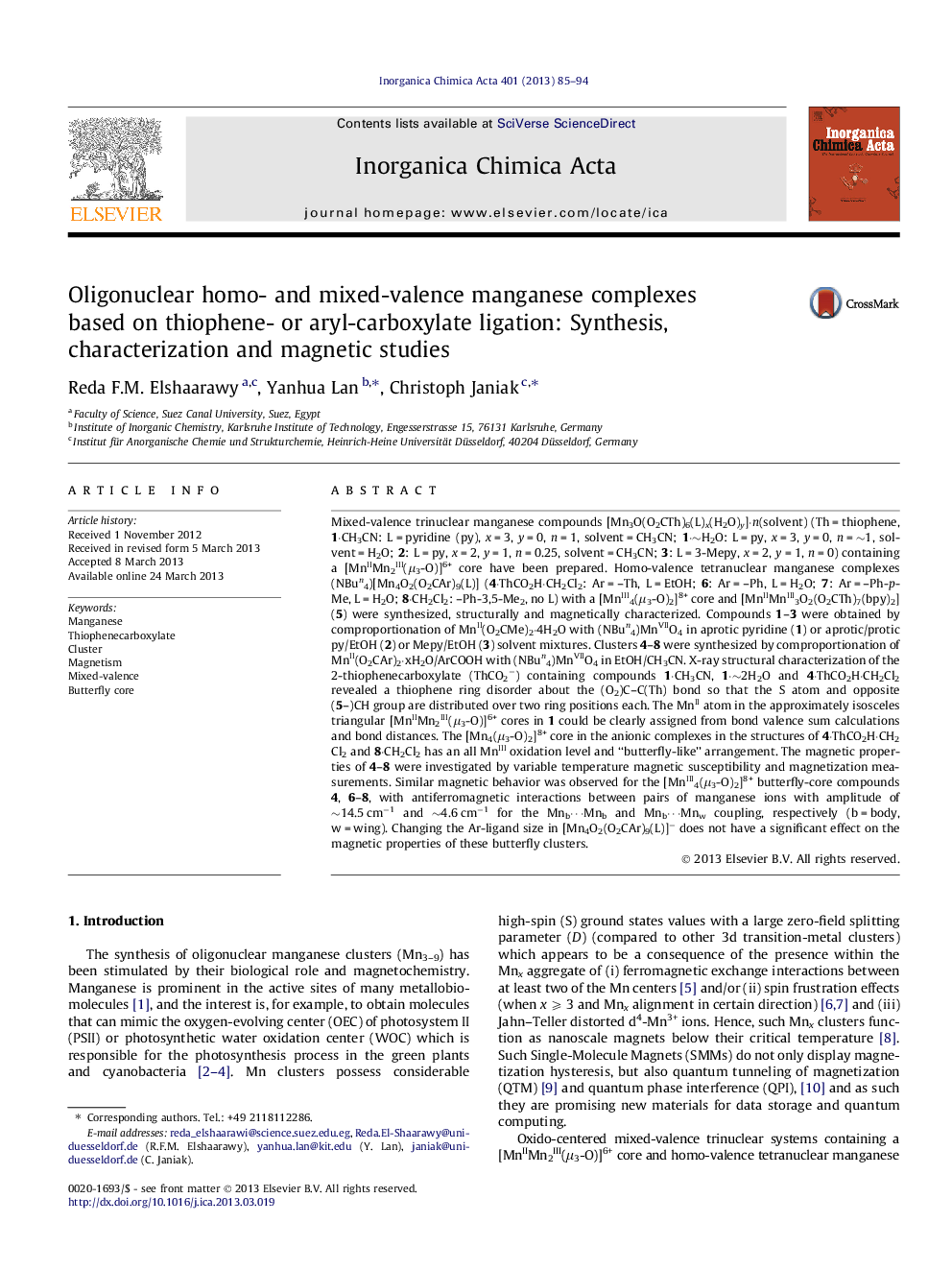| کد مقاله | کد نشریه | سال انتشار | مقاله انگلیسی | نسخه تمام متن |
|---|---|---|---|---|
| 1310424 | 1499186 | 2013 | 10 صفحه PDF | دانلود رایگان |

• First tri- and tetra-nuclear Mn complexes with a thiophene-(Th-)carboxylato ligand.
• Mixed-valence trinuclear Mn compounds with {MnIIMnIII2(μ-O)(O2CTh)6} core.
• Homo-valence tetranuclear Mn complexes with {MnIII4(μ-O)2(O2CAr)9} core.
• Mixed-valence tetranuclear Mn complex with {MnIIMnIII3(μ-O)2(O2CTh)7} core.
• Antiferromagnetic interactions dominate within tetranuclear clusters.
Mixed-valence trinuclear manganese compounds [Mn3O(O2CTh)6(L)x(H2O)y]·n(solvent) (Th = thiophene, 1·CH3CN: L = pyridine (py), x = 3, y = 0, n = 1, solvent = CH3CN; 1·∼H2O: L = py, x = 3, y = 0, n = ∼1, solvent = H2O; 2: L = py, x = 2, y = 1, n = 0.25, solvent = CH3CN; 3: L = 3-Mepy, x = 2, y = 1, n = 0) containing a [MnIIMn2III(μ3-O)]6+ core have been prepared. Homo-valence tetranuclear manganese complexes (NBun4)[Mn4O2(O2CAr)9(L)] (4·ThCO2H·CH2Cl2: Ar = –Th, L = EtOH; 6: Ar = –Ph, L = H2O; 7: Ar = –Ph-p-Me, L = H2O; 8·CH2Cl2: –Ph-3,5-Me2, no L) with a [MnIII4(μ3-O)2]8+ core and [MnIIMnIII3O2(O2CTh)7(bpy)2] (5) were synthesized, structurally and magnetically characterized. Compounds 1–3 were obtained by comproportionation of MnII(O2CMe)2·4H2O with (NBun4)MnVIIO4 in aprotic pyridine (1) or aprotic/protic py/EtOH (2) or Mepy/EtOH (3) solvent mixtures. Clusters 4–8 were synthesized by comproportionation of MnII(O2CAr)2·xH2O/ArCOOH with (NBun4)MnVIIO4 in EtOH/CH3CN. X-ray structural characterization of the 2-thiophenecarboxylate (ThCO2−) containing compounds 1·CH3CN, 1·∼2H2O and 4·ThCO2H·CH2Cl2 revealed a thiophene ring disorder about the (O2)C–C(Th) bond so that the S atom and opposite (5–)CH group are distributed over two ring positions each. The MnII atom in the approximately isosceles triangular [MnIIMn2III(μ3-O)]6+ cores in 1 could be clearly assigned from bond valence sum calculations and bond distances. The [Mn4(μ3-O)2]8+ core in the anionic complexes in the structures of 4·ThCO2H·CH2Cl2 and 8·CH2Cl2 has an all MnIII oxidation level and “butterfly-like” arrangement. The magnetic properties of 4–8 were investigated by variable temperature magnetic susceptibility and magnetization measurements. Similar magnetic behavior was observed for the [MnIII4(μ3-O)2]8+ butterfly-core compounds 4, 6–8, with antiferromagnetic interactions between pairs of manganese ions with amplitude of ∼14.5 cm−1 and ∼4.6 cm−1 for the Mnb⋯Mnb and Mnb⋯Mnw coupling, respectively (b = body, w = wing). Changing the Ar-ligand size in [Mn4O2(O2CAr)9(L)]− does not have a significant effect on the magnetic properties of these butterfly clusters.
Similar magnetic behavior was observed for the [MnIII4(μ3-O)2]8+ butterfly-core compounds with antiferromagnetic interactions of amplitude ∼14.5 cm−1 and ∼4.6 cm−1 between the body–body and body–wing pairs of manganese ions, respectively.Figure optionsDownload as PowerPoint slide
Journal: Inorganica Chimica Acta - Volume 401, 24 May 2013, Pages 85–94